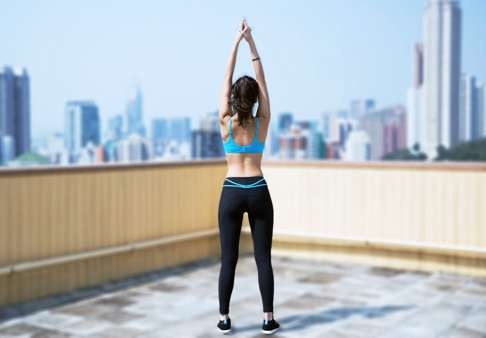
Can you lose cellulite? Hong Kong athleisure brand’s slimming leggings claim to do just that
Zarie leggings will reduce cellulite, water retention and weight in eight weeks, says crowdfunded brand’s founder, Stephanie Poon. However, doctors remain sceptical
If you’re a woman, it’s likely that you have some lumpy, dimpled flesh on your thighs, hips, buttocks and/or abdomen. Reality indeed sucks: cellulite plagues most women, even lean ones.
But what if you could reduce this unsightly “orange peel” appearance by just wearing special leggings for eights hours a day for eight weeks? That’s the promise of a new range of slimming leggings from Zarie, an athleisure brand founded by a Hong Kong entrepreneur.
“We are thrilled to offer a product that can be worn anytime, anywhere, and that is capable of helping women reduce weight and water retention in typical areas like hips, thighs, butt and tummy,” says Zarie founder Stephanie Poon. “The Dream Pants collection is crafted to fit each woman’s lifestyle while maintaining that aesthetic edge.”

According to Poon, women who tested her Dream Pants reported a 17 per cent improvement in skin elasticity after 56 days of use. The majority of testers also reported improvement in skin compactness (76 per cent), reduction of “orange peel” appearance (70 per cent) and visible improvements in the skin’s smoothness (78 per cent). It’s unknown how many women were involved in the testing and how scientific the procedure was.
The slimming leggings, which come in three lengths, claim to work through its special fabric, which is embedded with cosmetic micro-capsules containing ingredients that are said to control the appearance of cellulite. When worn, the ingredients – caffeine, retinol and vitamin E, fatty acids and aloe vera – are absorbed into the user’s skin, “resulting in improved blood circulation, reduced cellulite and lower body weight”, Poon claims. These ingredients are also commonly found in over-the-counter anti-cellulite creams.

“In theory, it is possible that if these microcapsules contain ingredients that have anti-cellulite potential, some benefit might be seen,” says Dr SM Yuen, CEO and medical director of Atlas Medical – Laser & Aesthetics Clinic in Singapore. “However, the question would be the effectiveness of the penetration of these ingredients, and how they remain stable within the composition of the leggings.”
He adds that the results are also likely to vary among individuals.
Dr Tan Siew Kiang, specialist in dermatology and consultant at Raffles Skin & Aesthetics Centre in Singapore, has more misgivings. Firstly, the use of many ingredients in anti-cellulite treatments is not backed by scientific evidence. One ingredient that has been critically evaluated is caffeine, and its efficacy has not been proven.
“Caffeine belongs to a group of biological agents known as methyxanthines, which can enhance the body’s ability to break down stored fat,” says Tan. “However, it remains a challenge for cosmetic products to penetrate the external and middle layers of the skin to reach the inner fat layer at a sufficient concentration – and for a long enough period of time, to be effective.”
She adds: “I am sceptical about the long term efficacy of such leggings. If they need to be worn for eight hours over eight weeks, will the technology be able to release the ingredients to penetrate the skin at a constant concentration, especially after regular washing?”
With the Dream Pants, the active ingredients last for up to 100 washes if hand washed, or 50 washes with cold machine washed, according to Poon, who formerly worked as a lingerie and swimwear designer.
Poon’s leggings are the latest in a slew of products launched over the years claiming to offer a quick cellulite fix. In 2011, British compression wear brand Proskins launched a line of anti-cellulite leggings that combine patented microencapsulated yarn (similar to Dream Pants) with compression fabric. Another brand, Playtex, uses a fabric that has “anti-mineral ceramic crystals” said to continuously massage the user’s legs as they walk, thereby improving circulation “on a micro level”.
Tan says these claimed effects are short-lived. “Consumers have to bear in mind that these leggings may have a temporary effect in reducing the appearance of skin dimpling, but they do not remove cellulite,” she says.

“Wearing tight leggings over a long period of time can cause excessive sweating, which may lead to fungal skin infections, particularly at skin fold areas,” says Tan. “Most importantly, patients with peripheral vascular disease, diabetes and existing skin disease should use such leggings with caution.”
In the battle against cellulite, it helps to understand what cellulite is. In medical terms, cellulite is caused by the herniation of subcutaneous fat within fibrous connective tissue. What this means is the normal skin structure that keeps fat in its place is weakened.
“When these walls and pillars are weakened, fats are not as well packed and they start to ‘leak’ out,” says Yuen. “Poor blood circulation also causes fibrous bands to form, and these pull the skin downwards and in awkward directions, causing fat to bulge intermittently.”
The result is a dimpled and uneven skin surface. Medical treatments often target the problematic fibrous bands, or what doctors refer to as fibrous septae.
Dr Darren Ng, a specialist in plastic surgery and a consultant at Raffles Skin & Aesthetics Centre, names Cellfina and Cellulaze as proven treatments for cellulite. “Cellfina mechanically breaks down the fibrous septae pulling on the dimples using an automated system which slides a miniature blade under the skin. Cellulaze uses a bidirectional laser beam delivered through a small fibre optic inserted through the skin to break down the fibrous septae and liquefy fat cells.”
Yuen recommends non-invasive remedies such as acoustic wave therapy (AWT) and radiofrequency therapy. AWT applies acoustic waves to areas affected by cellulite. Radiofrequency therapy uses thermal energy to contract the muscle layer and tighten loose, saggy skin.
“These treatments are quite well accepted to be effective in reducing cellulite. They improve micro blood circulation within cellulite tissue, and this allows the walls and pillars to become healthier, reducing the lumpiness of fat,” says Yuen.
For those who prefer more natural remedies, just eat better and get moving.
“Diet and exercise can reduce the amount of fat underneath the skin. This should reduce bulging between the fibrous septae, provided there is enough elasticity in the skin for the previously bulging area to retract instead of sag,” says Ng.
Poon’s fundraising campaign on local women-focused crowdfunding site Next Chapter has (at time of writing) raised more than US$10,000 from about 90 backers. Prices start from US$45 for a pair of slimming shorts. The campaign ends this Friday, May 6.

Three possible causes of cellulite
Experts aren’t exactly sure why cellulite forms. These are the top three factors, according to Dr Tan.
1. Genetics
Studies have found some genetic predisposition in females with cellulite. It leads to blood flow abnormalities, which facilitate the enlargement of fat cells and the formation of a complex mesh of subcutaneous fibrous tissue.
2. Poor diet
A diet excessively high in carbohydrates provokes hyperinsulinemia (where the body has more insulin relative to glucose in circulation) and promotes lipogenesis (the conversion of carbohydrates into fatty acids). This leads to an increase in total body fat content, and cellulite.
3. Sedentary lifestyle
Prolonged periods of sitting or standing may impede normal blood flow and alter the microcirculation of cellulite prone areas, such as the abdomen, pelvic region and legs, and worsen the condition.
